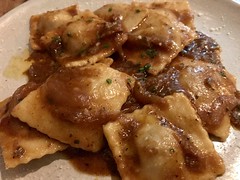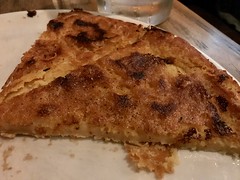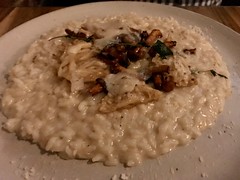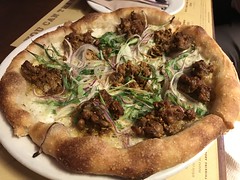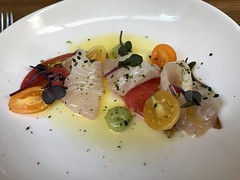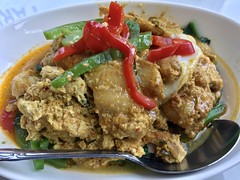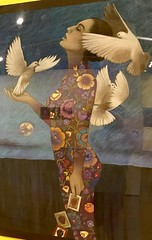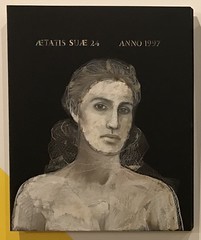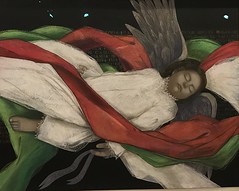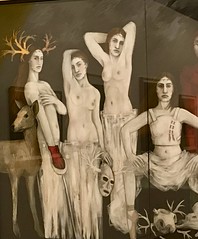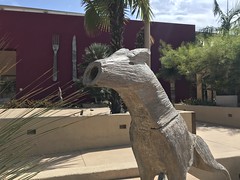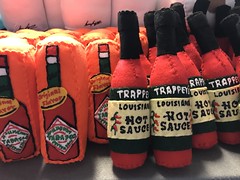Eating at Officine Brera in the DTLA Arts District always transports us back to fond memories of our trip to Tuscany. The vast room, an old warehouse space (very Arts District), has a modern vibe, and a nice view of the open kitchen, including their wood-burning ovens. (You can see the wood piled up by the front door.) They make some wonderful grilled meats and fish, and one of the ovens has a big crank / pulley thing for lowering down very large roasts. But they also make some terrific pastas. George often goes for the risotto, which tonight was carnaroli superfino rice with foraged mushrooms and Moliterno al tartuffo (a sharp aged pecorino – sheep’s milk cheese – from Sardinia, with veins of black truffle). I went for a new menu item, a venison ravioli with Nebbiolo-braised red onions and arrosto sauce (gravy from the roast). The meat was deliciously dark and rich, and it took me back to a dinner I had in Monteriggioni (an ancient Tuscan walled town) – that dinner was wild boar, but similar dark rich meat and sauce. We’d started this dinner with a light summer aperitif called “the Roz”, a flute of Plymouth gin, blackberry thyme sage shrub, lemon, and prosecco. And we always start with some farinata, a Tuscan chickpea crepe that we were delighted to discover in Florence, as it’s naturally gluten-free. Here at Brera, it is nicely blistered in their wood-burning oven. (It’s not on the menu, you just have to know to ask.) There was a salad of greens, grilled nectarine, lardon bits, chanterelles, and pistachios. And for dessert, a meringue with macedonia of summer fruit including more nectarines and amarena cherries. And of course an espresso.
Friday, August 31, 2018
FOOD: Pizzeria Mozza
Lunch at the famous Pizzeria Mozza: fennel sausage, mozzarella and cream, with slivered scallions and red onion. Thin crust bed that gets thick with beautifully blistered bubbles at the edge. House-made sausage is dollops of deliciously seasoned and cured ground meat (no need for casing just to put it on pizza). Green and red onions are sliced ultra thinly and lightly roasted, softened but still with a little bite and snap. GTK: reservations are scarce but if you’re content to sit at the bar, you can walk in at noon with no wait.
Saturday, August 25, 2018
FOOD: Orsa & Winston
This evening we were treated to the tasting menu at Orsa & Winston in DTLA. If you imagine how a chef with TexMex roots, trained in the classical European tradition, would prepare a Japanese omakase menu using mostly local ingredients from the local farmers market, that’s what you’ll get at Orsa & Winston. As Jonathan Gold said, “It tastes like Italy, Japan, and Spain. It tastes like Los Angeles.” The meal commenced with an amuse bouche of black sesame tofu topped with kombu and smoked trout roe, a rich dark bite set in a lovely blue-and-white patterned bowl. First course was a kanpachi (amberjack) crudo, fresh and mild, in a light yuzu dressing with red and yellow heirloom tomatoes and a couple little dollops of avocado, making a colorful array across a plain white plate. Next up was a duck foie gras au torchon, garnished with huckleberries, white figs, and labneh, with toast to spread the smooth rich pâté on. The “second course” (as is traditional with tasting menus, a “six course menu” ends up being more like ten) was a chilled summer melon soup, sweet cantaloupe-colored juice poured over some Hokkaido scallops, slivers of jicama, and little pieces of oro blanco grapefruit and cucumber. Third was a piece of seared aji (mackerel) with seared baby corn, malabar spinach, and a chopped walnut bagna cauda. (Yeah, I don’t know what all that stuff is either, and we often consult Google while decoding menus. Bagna cauda is a Piedmontese dipping sauce made from olive oil blended with garlic and anchovy. Don’t let the anchovy put you off. It’s all blended in, just good tasty dressing, here with chopped walnut added.) Fourth up was a “satsuki rice porridge”, like a risotto but with a short-grained plump Japanese rice and seasoning, with slices of abalone, pieces of geoduck (a long-necked clam), and Santa Barbara uni (sea urchin). Fifth, the meat course, was a Sonoma lamb T-bone with cannellini beans, cherry tomatoes, maitake mushrooms, some dark leafy green, and some minced castelvetrano olives. A palate cleanser of coconut sorbetto with passionfruit pulp was a lovely light segue into dessert, which was a peach clafoutis with a hearty dollop of crème fraiche Chantilly. (If you’re again diving for Google, a clafoutis is a custardy batter mixed with fruit and baked, so that unlike a pie or a cobbler, the fruit is baked right into the pastry. To be appropriately decadent, we did the wine pairings, which were really interesting. Though all Italian and French, the varietals and regions were mostly unfamiliar ones: a folle blanche from the Loire was very tart to pair with the crudo, a lagrein from the Dolomites made a dark rosato with berry notes that made a lovely compliment to the melon soup, and a dry white sciaglin from Venezia-Giulia made for pasta and aged cheese paired nicely with the rice porridge and shellfish. The desert wine was a moscato from Sicily where they press the grapes earlier, not letting them turn into raisins as is more typically done, for a light sweetness instead of a more typical syrupy moscato. It was lovely with the light pastry, fruit, and cream. We parted happy from good company and the tastes of Los Angeles in our bellies, feeling lucky to live in this city. (See full set of photos here.)
Friday, August 24, 2018
Long Beach: CambodiaTown and Judithe Hernández at the MoLAA
With another off-Friday opportunity to explore my city, I headed down to Long Beach. For lunch, Cambodian food was on the menu. In one of those quirks of human migration patterns, the stream of Cambodian emigrants in the wake of the 1979 fall of the Khmer Rouge regime ended up concentrating in Long Beach, and creating a CambodiaTown along Anaheim Blvd. Arguably ground zero of CambodiaTown has been a place called Sophy’s (or also called CambodiaTown Food & Music), a restaurant but also a bit of market and community center. I’d been tipped off by Eater.com that a dish called amok trey was a great intro into authentic Cambodian cuisine. Amok trey is made from catfish fillets rubbed with kroeung -- a curry paste, and steamed with red and green peppers -- and some leafy veg with a stalk (similar to Chinese broccoli). The curry paste has similar ingredients to Thai curry - lemongrass, galangal, chili, kaffir lime - but a bit more sour than Thai. This fish was mild, tender, and delicious.
After lunch, my culture target was the Museum of Latin American Art, where a new exhibition of Judithe Hernández had just opened. I wasn’t familiar with the artist, but when I saw some of the striking images of her work, and when I learned that she was a cohort of Carlos Almaraz, whose work I’d really appreciated at a LACMA exhibit last summer, I knew I wanted to check it out. As the only female artist in the art collective Los Four, and one of the few female artists in the Chicano art movement at all, she developed a strong feminist identity expressed in her work. She works almost exclusively in pastel on paper, with figurative depictions of women, with a dream-like quality that conveys these women as archetypes to be read symbolically rather than portraits of specific actual women. A number of her works are set in vivid botanical landscapes, Rousseau-like jungle foliage or desert scapes, and some contain dream-like animals. This sort of magical realism will suggest comparisons to Frida Kahlo, but Hernández has her own clearly distinct style and vision. A number of the pieces express pointed commentary on contemporary events. One set, called the Juarez series, reflects on the spate of random murders of women and girls around Ciudad Juarez. There have been hundreds of these “feminicides” since 1993, with no apparent motive, just women violently killed, their bodies left in the desert. In The Unknown Saint, a ghostly woman on her back seems to float above a stand of cactus in the desert under a full moon night sky, a thin blood-red ribbon coiled around her grey neck and trailing off different directions into the expanse of desert. This large mural is hauntingly beautiful. In another part of the Juarez series, a trilogy of small portraits of women echoes a European Renaissance tradition of aetatis suae portraits, in which families with marriageable young daughters would have portraits painted, annotated with the age of the girl and the year, for circulation around society soliciting suitors. Here Hernández, in a biting riff on the classical form, has painted portraits of young women with their age and year of their untimely deaths. Another very recent work, reacting to then-candidate Trump’s comments on Mexican immigrants, draws on a Spanish Colonial tradition of dressing deceased infants in saintly garments. Her Death of the Innocents memorializes a young child lost to the dangers of attempts to cross the northern Mexican deserts to get the United States. The deceased child is dressed as a saint, with red and green sashes (colors of the Mexican flag), and holding a ribbon that says “we come but to dream”. Though mortality is certainly a prevalent theme in her work, it’s not entirely pervasive. Other works (like Jungle of Fire, The Birth of Eve, and Garden of Dreams) are vivid dreamscapes. Some are provocative in other ways. Les Desmoiselles d’Barrio is her feminist pastiche of Picasso's seminal work, Les Desmoiselles d'Avignon. Her desmoiselles are much more formidable, with luchadora (Mexican wrestling) masks, and some armed with rapiers. For Hernández, women have layers of masks. Even with their luchadora masks removed, these women's faces are identical, and appear stitched onto their heads.
After being immersed in the colorful dreamlands of Judithe Hernández, I stepped into the sunlight of the Gumbiner Sculpture Garden, where a collection of modern sculpture by Latin artists is set amidst cactus and palms. A few particularly caught my eye. I liked Gaudi Esté’s Perro Nagual con cara de conejo (rabbit-faced dog spirit), a figurative bronze howling at the moon. In Williams Barbosa’s Danza no 1, the curve and sweep of the two tall red iron abstracts had be thinking “Fred and Ginger” before I even saw the title. Carlos Luna’s comic War-Giro looks like a goofy sheriff from the front with his skeleton exposed on the back. Gustavo López Armentia’s Objetos del Mundo (objects of the world) is a monumental fork and knife with hieroglyphic-like symbology (more worldly objects) carved into them when you look up close. All in all, definitely worth the short drive down to Long Beach. (See complete set of photos from the day here.)
After lunch, my culture target was the Museum of Latin American Art, where a new exhibition of Judithe Hernández had just opened. I wasn’t familiar with the artist, but when I saw some of the striking images of her work, and when I learned that she was a cohort of Carlos Almaraz, whose work I’d really appreciated at a LACMA exhibit last summer, I knew I wanted to check it out. As the only female artist in the art collective Los Four, and one of the few female artists in the Chicano art movement at all, she developed a strong feminist identity expressed in her work. She works almost exclusively in pastel on paper, with figurative depictions of women, with a dream-like quality that conveys these women as archetypes to be read symbolically rather than portraits of specific actual women. A number of her works are set in vivid botanical landscapes, Rousseau-like jungle foliage or desert scapes, and some contain dream-like animals. This sort of magical realism will suggest comparisons to Frida Kahlo, but Hernández has her own clearly distinct style and vision. A number of the pieces express pointed commentary on contemporary events. One set, called the Juarez series, reflects on the spate of random murders of women and girls around Ciudad Juarez. There have been hundreds of these “feminicides” since 1993, with no apparent motive, just women violently killed, their bodies left in the desert. In The Unknown Saint, a ghostly woman on her back seems to float above a stand of cactus in the desert under a full moon night sky, a thin blood-red ribbon coiled around her grey neck and trailing off different directions into the expanse of desert. This large mural is hauntingly beautiful. In another part of the Juarez series, a trilogy of small portraits of women echoes a European Renaissance tradition of aetatis suae portraits, in which families with marriageable young daughters would have portraits painted, annotated with the age of the girl and the year, for circulation around society soliciting suitors. Here Hernández, in a biting riff on the classical form, has painted portraits of young women with their age and year of their untimely deaths. Another very recent work, reacting to then-candidate Trump’s comments on Mexican immigrants, draws on a Spanish Colonial tradition of dressing deceased infants in saintly garments. Her Death of the Innocents memorializes a young child lost to the dangers of attempts to cross the northern Mexican deserts to get the United States. The deceased child is dressed as a saint, with red and green sashes (colors of the Mexican flag), and holding a ribbon that says “we come but to dream”. Though mortality is certainly a prevalent theme in her work, it’s not entirely pervasive. Other works (like Jungle of Fire, The Birth of Eve, and Garden of Dreams) are vivid dreamscapes. Some are provocative in other ways. Les Desmoiselles d’Barrio is her feminist pastiche of Picasso's seminal work, Les Desmoiselles d'Avignon. Her desmoiselles are much more formidable, with luchadora (Mexican wrestling) masks, and some armed with rapiers. For Hernández, women have layers of masks. Even with their luchadora masks removed, these women's faces are identical, and appear stitched onto their heads.
After being immersed in the colorful dreamlands of Judithe Hernández, I stepped into the sunlight of the Gumbiner Sculpture Garden, where a collection of modern sculpture by Latin artists is set amidst cactus and palms. A few particularly caught my eye. I liked Gaudi Esté’s Perro Nagual con cara de conejo (rabbit-faced dog spirit), a figurative bronze howling at the moon. In Williams Barbosa’s Danza no 1, the curve and sweep of the two tall red iron abstracts had be thinking “Fred and Ginger” before I even saw the title. Carlos Luna’s comic War-Giro looks like a goofy sheriff from the front with his skeleton exposed on the back. Gustavo López Armentia’s Objetos del Mundo (objects of the world) is a monumental fork and knife with hieroglyphic-like symbology (more worldly objects) carved into them when you look up close. All in all, definitely worth the short drive down to Long Beach. (See complete set of photos from the day here.)
Saturday, August 18, 2018
The Difference Between A President And A Dictator
The difference between a president and a dictator is that a president presides over a nation of laws where the power of government can only be wielded with due process, while a dictator is an exercise of power at will, doing whatever he wants merely because he wants to. In our constitutional republic, no president should be allowed any arbitrary exercise of power that allows him to punish anyone he deems to be his enemy. Yet that is precisely what is happening with Trump acting to revoke the security clearance of former senior intelligence officials who criticize him. It is not only retaliation against Trump’s perceived enemies, but it is fully intended to send a message to others. This politicization of the security clearance process must not be tolerated. This is completely Nixonian territory. With Nixon, it was using the IRS to inflict tax audits as harassment, and using federal contracts and grants as the president’s personal tokens of favor or disfavor. A then-secret internal memo from the Nixon White House outlined “how we can use the available federal machinery to screw our political enemies”. (Yes, that’s a quote.) This abuse of power was among the articles of impeachment against Nixon. What Trump has done to John Brennan, and is threatening to do to others, is no different. This is behavior one would expect from the leader of Cuba or Zimbabwe or Russia, but not the United States.
Friday, August 17, 2018
ART: Sparrow Mart
This evening my husband and I stopped by Sparrow Mart, a unique art installation at The Standard Hotel DTLA. British artist Lucy Sparrow works almost exclusively in felt and makes what are essentially hand-painted felt plushies. She and a small crew of crafters in her studio hand-made 31,000 items that are replicas of things you would find in a typical southern California market, and stocked an entire market. Plushy condiments, plushy candy bars, plushy cigarettes, a deli case, a seafood counter with little plushy clams, scallops, and salmon filets, plushy sushi. There's a full-size felt ATM spitting out a felt receipt and felt money. The detail is delightful. It's so whimsical and so inventive, you can't help but smile in amazement. These items are all actually on sale, and there are market baskets and a check-out counter. We saw people loading up their baskets. This unique art exhibit will be on display through the end of August, or until the shelves are empty, whichever comes first!
Wednesday, August 15, 2018
BOOKS: Kitchen Confidential
For some ridiculous reason, I had somehow managed to not really know who Anthony Bourdain was until after his death. The outpouring of praise in response to his tragic end finally motivated me to see what I’d been missing, so I picked up his first big book Kitchen Confidential: Adventures in the Culinary Underbelly. I’m way late to join the chorus, but I will heartily join the voices of praise. As promised, the book is an eye-opening tour of the “back of house” of the restaurant business, giving me a whole new appreciation for what goes on back there. We think of chefs as being all about the culinary creativity, but that’s just a small part of the job, which includes marshalling supplies of food and tools from a network of suppliers of varying scrupulousness and reliability, managing a staff mostly comprised of miscreants and undocumented immigrants, and playing HR, confidant, and motivator to get them to produce a consistent high quality product at intense volume. His description of the pre-theatre dinner rush at a Times Square eatery will make you appreciate a chef not just as a food artist, but also like Omar Bradley planning and executing the landing at Utah Beach. His description of the colorful characters that inhabit the kitchen, and the choreography that somehow emerges from barely controlled mayhem, will make you want to peek behind the kitchen door, but will also make you very afraid to get too close. Bourdain has the rare gift of writing like he talks (and bonus: he reads his own audiobook), and the book is not only a window on the restaurant world, but also a window on this extraordinary man. He is impressed with his own talents, sometimes self-confessedly beyond justification, but he has a deep respect for his craft, and is quick to take his hat off to his peers and superiors. He desires to do a good job for its own sake, and gives restaurant owners their due if not always respect, but he’s fiercely loyal to his employees. His prose is vivid, and I enjoyed the journey from Bourdain as a boy in France tasting his first oyster to the seasoned chef making his first explorations of the Tokyo food scene, or just the chef examining his own hands, their scars, and the stories they tell. I’m sorry I didn’t know him sooner. I miss him already.
Sunday, August 12, 2018
Attempt to Neuter the EPA Under Guise of Scientific Transparency
We have until Thursday, Aug 16, to provide comments on a proposed EPA rule that is intended to neuter the EPA’s ability to regulate air pollution, water contaminants, and toxic chemicals. It’s a parting gift from recently-resigned-in-disgrace EPA Administrator Scott Pruitt, whose aim in running the Environmental Protection Agency was essentially to stop protecting the environment. The rule is actually a bit of evil genius. It cloaks itself in lofty aims of scientific transparency, requiring the EPA to consider only scientific studies whose data sets are publicly available for replication. It sounds quite reasonable on the surface, until you realize that medical studies inevitably involve confidential medical information about actual people, and that making their data sets public would mean publishing the private medical info of all those people who participated in the study. That’s obviously a non-starter, and the effect would be that in trying to decide whether certain chemicals and pollutants are harmful to human health, the EPA would be prohibited from consulting any scientific studies involving humans. And if the EPA’s own rules keep it from looking at medical studies to see whether chemicals cause any harm, then they can’t make any regulations enforcing safety measures. This is the dream of those like Pruitt who believe that science itself is just a liberal conspiracy to thwart business growth by making pesky regulations against dumping toxic waste into our rivers and harmful particulates into our air. If you care about clean air, clean water, and a healthy environment, you will want to comment on this proposed rule.
If you want to read more about it, there’s a great article in The Atlantic here: https://www.theatlantic.com/science/archive/2018/07/scott-pruitts-secret-science-rule-could-still-become-law/565325/
You can read the actual proposed rule and comment on it here: https://www.regulations.gov/document?D=EPA-HQ-OA-2018-0259-0001
Here is the comment that I submitted:
If you want to read more about it, there’s a great article in The Atlantic here: https://www.theatlantic.com/science/archive/2018/07/scott-pruitts-secret-science-rule-could-still-become-law/565325/
You can read the actual proposed rule and comment on it here: https://www.regulations.gov/document?D=EPA-HQ-OA-2018-0259-0001
Here is the comment that I submitted:
I am deeply concerned about the effect this proposed rule would have on the ability of the EPA to protect human health, as is its charter. As should be well known to the EPA, most large-scale medical studies inherently involve data sets bound up in patient privacy, with specific medical details such that anonymization or redaction of the data would be impossible without compromising either privacy or replicability. The upshot of this rule is that when evaluating policies on air pollution, water contaminants, and toxic chemicals, and their effect on human health, the EPA would be prohibited from consulting any scientific research on actual humans. Even though this rule is written to affect only prospective rulemaking, its effect should be studied by looking at how past rules might have come out differently had this rule been in effect. A good example is the 1993 Harvard “Six Cities” study that was pivotal in establishing EPA policies regulating particulate matter, but which is often cited as so-called “secret science”. This study, which is a model for responsible science, having established protocols to support replication without violating patient confidentiality, has been replicated both in independent reviews of its own data set, and in similar studies of other data sets. Yet, because it cannot make its data public without violating patient confidentiality, it would be excluded by this rule, and if the rule were given retrospective effect, we could well lose well-founded health protections against the harms of particulate matter. I submit that any rule that would exclude studies such as this one violates the EPA’s fundamental charter to protect human health, and must be revised. And it would not be sufficient to rely on discretionary exceptions to allow studies such as this. These type of studies are the norm, and not the exception, and must be accommodated by any EPA rule fundamentally and not just on an exceptional basis.
Saturday, August 11, 2018
STAGE: Waitress
 The heroine of the musical Waitress is Jenna, who works at a diner in an unnamed southern town, and has a creative genius for making pies with fanciful names and unexpected combinations of ingredients. This show takes an unexpected combination of ingredients – an abusive husband, an unwanted pregnancy, extramarital affairs, women trapped by hard economic circumstances – and bakes all of that into an unexpectedly delicious feast for the eyes, ears, and heart. The choreography is impressive, with the cast dancing around and the diner’s tables, tray carts, and pantry shelves often playing moving parts in the dance. The Sara Bareilles tunes are charming with witty lyrics that define the characters and propel the story, and Desi Oakley as Jenna does a great job serving them up with impressive stylings like falls and runs near the end of big long notes. Charity Angél Dawson was sassy as Jenna’s friend and co-worker Becky, and shined in her big number “I Didn’t Plan It” at the top of Act Two. And Oakley has some lovely duets with Bryan Fenkart (Dr. Pomatter), particularly “A Really Good Bad Idea” at the end of Act One. Despite some dark and heavy themes, there’s enough sugar in this pie to balance it. I smiled a lot and laughed, including a couple tipping-head-back roaring laughs, at the same time as appreciating its more serious commitments, but it is dessert in the end. If you have a chance to catch this while it’s still at the Pantages (through Aug 26), we recommend it.
The heroine of the musical Waitress is Jenna, who works at a diner in an unnamed southern town, and has a creative genius for making pies with fanciful names and unexpected combinations of ingredients. This show takes an unexpected combination of ingredients – an abusive husband, an unwanted pregnancy, extramarital affairs, women trapped by hard economic circumstances – and bakes all of that into an unexpectedly delicious feast for the eyes, ears, and heart. The choreography is impressive, with the cast dancing around and the diner’s tables, tray carts, and pantry shelves often playing moving parts in the dance. The Sara Bareilles tunes are charming with witty lyrics that define the characters and propel the story, and Desi Oakley as Jenna does a great job serving them up with impressive stylings like falls and runs near the end of big long notes. Charity Angél Dawson was sassy as Jenna’s friend and co-worker Becky, and shined in her big number “I Didn’t Plan It” at the top of Act Two. And Oakley has some lovely duets with Bryan Fenkart (Dr. Pomatter), particularly “A Really Good Bad Idea” at the end of Act One. Despite some dark and heavy themes, there’s enough sugar in this pie to balance it. I smiled a lot and laughed, including a couple tipping-head-back roaring laughs, at the same time as appreciating its more serious commitments, but it is dessert in the end. If you have a chance to catch this while it’s still at the Pantages (through Aug 26), we recommend it.Sunday, August 05, 2018
Say No To Census Citizenship Question
This Tuesday Aug 7 is the deadline for public comment on an insidious proposal to add a citizenship question to the 2020 census. While that may seem innocuous, one should appreciate how fraught the current situation is for non-citizens in America today, and how unlikely they would be to respond to a government questionnaire asking about citizenship. Why is it important to count non-citizens? Our US Constitution requires a census every ten years to enumerate all residents for the purpose of apportioning representation. Note that this count is specifically of residents and not just citizens, and the census has counted non-citizens since the first census in 1790. If the non-citizen population of California (and other states with a higher share of immigrants) is undercounted, California could be apportioned fewer representatives in Congress and fewer electoral votes. At a time when immigration policy is being hotly debated, it is crucial for the states who actually have the most at stake to have the appropriately apportioned voice in the debate.
Anybody is invited to comment on the proposed government action. Follow this link: https://www.regulations.gov/docket?D=USBC-2018-0005 and look for the “Comment Now” button. Your comment can be as brief or lengthy as you like, and feel free to add any personal perspective or examples on how this could affect you. Here was my comment:
I strongly urge the Commerce Department to remove the citizenship question from the 2020 Census form. Including an untested, controversial question will undermine the quality and accuracy of the census. The Census Bureau's own Chief Scientist warned of lower response, much higher costs, and a less accurate census if the citizenship question is included (see note 1). Including a citizenship question puts the census at grave risk of a significant undercount, especially among hard-to-reach population groups that already are fearful of answering government surveys, according to the bureau's own research. An accurate enumeration of residents is the constitutional charge of the census, and a citizenship question must not be allowed to jeopardize that constitutional purpose for the census. Moreover, the apparent political motivation of the late addition of a citizenship question (see note 2, e.g.), and the apparent top-down direction to add this question despite contrary advice from agency experts, threatens to erode public faith in fundamentally non-partisan government functions such as the Bureau of the Census. At a time when public faith in government institutions is ebbing, we can ill afford such a mistake.
(1) Memo from John M. Abowd, "Technical Review of the Department of Justice Request to Add Citizenship Question to the 2020 Census", 19 Jan 2018.
(2) “Document Sheds Light On Decision To Add Census Citizenship Question”, NPR, 10 Jun 2018.
Anybody is invited to comment on the proposed government action. Follow this link: https://www.regulations.gov/docket?D=USBC-2018-0005 and look for the “Comment Now” button. Your comment can be as brief or lengthy as you like, and feel free to add any personal perspective or examples on how this could affect you. Here was my comment:
I strongly urge the Commerce Department to remove the citizenship question from the 2020 Census form. Including an untested, controversial question will undermine the quality and accuracy of the census. The Census Bureau's own Chief Scientist warned of lower response, much higher costs, and a less accurate census if the citizenship question is included (see note 1). Including a citizenship question puts the census at grave risk of a significant undercount, especially among hard-to-reach population groups that already are fearful of answering government surveys, according to the bureau's own research. An accurate enumeration of residents is the constitutional charge of the census, and a citizenship question must not be allowed to jeopardize that constitutional purpose for the census. Moreover, the apparent political motivation of the late addition of a citizenship question (see note 2, e.g.), and the apparent top-down direction to add this question despite contrary advice from agency experts, threatens to erode public faith in fundamentally non-partisan government functions such as the Bureau of the Census. At a time when public faith in government institutions is ebbing, we can ill afford such a mistake.
(1) Memo from John M. Abowd, "Technical Review of the Department of Justice Request to Add Citizenship Question to the 2020 Census", 19 Jan 2018.
(2) “Document Sheds Light On Decision To Add Census Citizenship Question”, NPR, 10 Jun 2018.
Saturday, August 04, 2018
FILM: Mamma Mia! Here We Go Again
It’s Wednesday morning and I still have those catchy Abba tunes playing in my head from seeing the new Mamma Mia movie on Saturday, along with visions of breezy sunny romances on gorgeous Greek islands. If you liked the first Mamma Mia, you’ll like this new installment even better. This prequel/sequel interleaves story lines of Sophie sometime after the first film leaves off and a young Donna showing us the events that lead to her landing on a remote island and getting pregnant with uncertain paternity. Not only do the writers work in excuses for a whole party of Abba tunes, but they also flesh out Donna’s back story fitting in every hint that we’d heard about it before. Lily James gives a great performance as young Donna, and we meet a charming trio of young actors playing the three possible fathers. Amanda Seyfried equally shines in her return as Sophie, and a bunch of familiar actors from the first film are fun to see again. Meryl Streep, when she turns up, is wonderful and made me cry. The only disappointment was Cher, whom you’d think would be a natural playing a big diva, but came across unexpectedly flat and frail (though in fairness the script gave her only a cardboard character to work with). But that small off note didn’t spoil the party. We laughed, we cried, and we walked out smiling and humming.
Thursday, August 02, 2018
FILM: Marshall
Chadwick Boseman made two superhero movies this past year, and I just got the chance to watch the other one. Both heroes were endowed with great intellect and judgment in their quest for justice, but unlike the Black Panther whose physical abilities were enhanced by technology and magic herbs, Thurgood Marshall's only power was the law, and an appeal to his fellow citizens' sense of justice. It was not a superpower that enabled him to overcome two-on-one odds in a bar fight, but it was a superpower that enabled him to win over a reluctant co-counsel, a white jury in Connecticut in 1941, and over time help transform a nation. The story is at core a good old-fashioned courtroom drama, very black-and-white, if you will, about which side to root for, and just enough twists to provide a reasonable doubt about the inevitable outcome. The film does a great job of capturing the time and place, with a color palette that gives that vintage impression of sepia tone, while actually being in color. It also conveys the racial atmosphere of the time and place, showing us that a black defendant getting a fair trial wasn't a problem limited to the South, as well as showing the personal courage and the obstacles large and small faced by these early crusaders for racial justice in the courts. Crusaders is plural here, as, though the young cock-sure Thurgood Marshall is the main hero, this is also the origin story of lesser-known crusader Sam Friedman, a Jewish attorney who gets dragged into this case unwittingly as local counsel, but by the end, finds his calling with the NAACP. Bravo both to Boseman and Josh Gad for their sensitive portrayals of these heroes. Especially at this moment in our history, it is good to be reminded which way the arc of the moral universe bends.
Subscribe to:
Posts (Atom)
